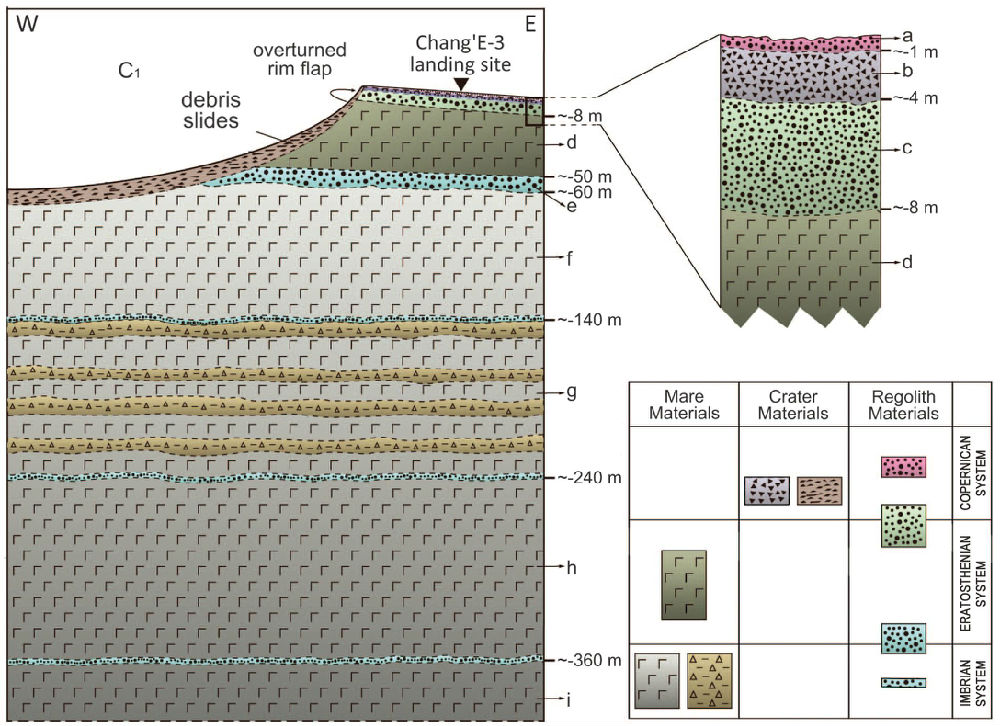博文
“玉兔”首次揭秘月球浅表地质结构
||
Science最近的一项研究刊登了我国“嫦娥三号”探月工程的最新探测成果。利用嫦娥三号的探测数据,我国科学家首次研究报道了雨海北部地区的地质特征及其浅表层的地质结构,对于探索月球的岩浆演化历史和后期改造作用具有非常重要的意义。
Chineselunar mission Chang’E-3 is the latest in-situ exploration to the Moon after theApollo and Luna missions finished 40 years ago. It is composed of a lander anda rover (Yutu: named after the jade rabbit on the Moon in a Chinese fairytale). Yutu rover is equipped with several scientific instruments including alunar penetrating radar (LPR), whose measurement has never been carried out ona rover. After integrating the LPR data with other in-situ and geologicalinformations, Xiao et al. [1] discovered several subsurface layers in northernMare Imbrium, which reveals a much morecomplex geological history than previous thought.
The surface ofthe landing site is within the Eratosthenian materials [2], which is youngerthan those of the Apollo and Luna landing sites. In the landing area, impactcraters with different sizes and degradations were observed. Among the freshejecta deposits, a ~4 m long, ~1.5 m high boulder (Loong Rock) is of particularinterest. It looks homogeneous with the ~1.5 to 2 cm light color crystals inhigh resolution images taken by Panoramic Camera, and it is distinct in texturefrom the samples obtained by the Apollo missions.
The mostsignificant advance is the subsurface structure revealed by LPR (Figure 1). LPRhas two channels (Channel 1: 60 MHz and Channel 2: 500 MHz), which weredesigned to detect subsurface layers with different depths and resolutions [3]:Channel 1 radar can disclose subsurface interface deep to ~400 m, while Channel2 radar can “see” depth shallower than 12 m but with greater detail. LPR observedthe interface of Eratosthenian and Imbrian, which is consistent with thethickness of Eratosthenian determined by impact crater [4]. In addition,several layers of paleoregolith were also detected, and they demonstrated theexistence of intervals of different volcanic eruptions and subsequent spaceweathering processes. These thicknesses of the paleoregolith layers could helpus understand the rate variations of space weathering through time. Besides thepaleoregolith layers, LPR discovered several distinct layers that could becomposed of pyroclastic materials. They revealed the changes of eruption styleduring emplacement of the Imbrian volcanic materials.
Severalquestions still need to be addressed in future study: 1) What were theconditions forming the coarsegrained Loong Rock? 2) What were the rates ofspace weathering in the Imbrian and what were the reasons for the ratevariations? 3) What were the key elements controlling the changes of volcaniceruption and/or overflow style?

Figure 1 (Color online) Sketchedgeological cross section and an inferred profile of the CE-3 landing site. Yutu has detected seven subsurfaceinterfaces,which formed from imbrian to Copernican. Lettersfrom ‘a’ through ‘i’ indicateinterpretedsubsurface layers based on the LPR data (From Xiao et al. [1]).
相关文章:
订阅《中国科学: 物理学 力学 天文学》微信公众号,手机同步关注最新热点文章、新闻、科技资讯, 请添加微信号SCPMA2014或扫描下方图片关注.

https://blog.sciencenet.cn/blog-306503-901630.html
上一篇:如何更好地使用北斗导航电文
下一篇:【仔仔新作】月亮和太阳